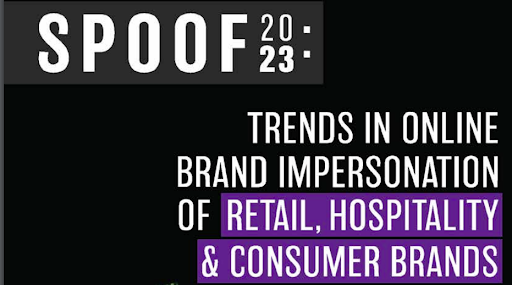BLOG
Articles about website spoofing, cybersecurity trends, and how to protect your customers from hackers.
Exclusive Report: The State of Online Consumer Brand Impersonations in 2023
There’s no denying the importance of online sales to retail and other consumer-facing brands. Forecasts predict worldwide e-commerce sales will grow 56% in the coming years reaching $8.1 trillion by 2026. Scammers know this, and work hard to develop new, creative ways to steal from unsuspecting shoppers. Online brand impersonation directly threatens brand integrity and customer trust. It’s a complex issue that directly impacts marketing efficiency and consumer perception, extending beyond the traditional boundaries of cybersecurity and fraud prevention.
Our latest report SPOOF23: Trends in Online Brand Impersonation of Retail, Hospitality, and Consumer Brands offers crucial insights into the scale and complexity of this issue, across consumer, retail and hospitality industries. The findings reveal a troubling rise in the number of cybercriminals that imitate legitimate brands to deceive customers, dilute marketing efforts, and divert revenue. You can explore these evolving challenges in detail by downloading the full report.
For retailers, understanding this threat is vital to developing a response. The effectiveness of marketing campaigns, the protection of customer relationships, and the strength of brand reputation all depend on it.
The State of Online Brand Impersonations for Consumer Brands
Our data has revealed increases in online brand impersonation incidents, particularly in the retail sector. This pattern, detailed in our SPOOF23 report, offers a unique insight into the tactics employed by fraudsters and how they impact both consumer spending and trust. Dive deeper into these findings by downloading the report.
From January through July 2023, we observed an escalation in the frequency of these impersonations. The data reveals a distinct pattern: a notable surge in impersonation attempts immediately following major shopping events and holidays. For instance, the post-Valentine’s Day period saw a sharp increase in fraudulent activities, indicating a strategic timing by scammers to exploit peak shopping seasons.
Looking at Allure Security online brand impersonation detection data, the most impersonated categories were Apparel and other Consumer Products, accounting for over 75% of all incidents detected. This indicates a clear preference by fraudsters for sectors with high consumer engagement and spending. Apparel, being the most impersonated category, highlights the attractiveness of fashion and lifestyle products to online scammers.
For retailers, the implications are clear: staying ahead of these impersonation tactics is not just about protecting revenue, but also about safeguarding brand reputation and maintaining customer trust. Understanding the scope and nature of these threats is the first step in evolving defense strategies to combat this new wave of digital deception.
Understanding and Addressing Emerging Threats in Consumer Brand Impersonation
Online brand impersonation is not just a singular problem but a multifaceted threat with evolving dimensions. Our report reveals the dynamic and challenging environment for consumer brand protection, highlighting not only diverse impersonation tactics but also the emerging threat of deceptive advertising, particularly on Meta platforms.
Scammers continually innovate, moving beyond traditional domain name spoofing to using obscure methods like random name combinations for domains. These tactics, which also include fake social media profiles and bogus websites, are harder to detect and pose a significant challenge for brand protection.
The Surge of Fake Meta Ads:
An alarming development is the increase in fake ads on Meta platforms, such as Facebook and Instagram. These ads often mimic legitimate marketing campaigns, offering attractive discounts to lure consumers to fraudulent websites. The impact is twofold: they not only divert potential customers from genuine sites but also inflate marketing costs for real brands as they compete for visibility in the same digital space.
The Rise of Generic Online Scam Storefronts
A notable trend is the emergence of generic online scam storefronts. These platforms don’t directly impersonate a specific brand but offer an array of products, often at implausibly low prices. This subtle form of deception damages brand reputation, misleads consumers, and is not as easily detected.
Strategic Response for Retailers
To effectively counter these threats, retailers need to:
- Enhance their monitoring efforts across more digital channels
- Educate customers about the risks of fake ads and how to spot them
- Build relationships and collaborate with online platforms for quicker takedown of fake ads and fraudulent sites
- Implement automated, AI-driven detection tools for a more proactive and comprehensive defense
The online consumer brand impersonation landscape is witnessing a shift, demanding a more nuanced and agile response from brands. Understanding these threats and employing advanced solutions is key when it comes to safeguarding brand integrity and maintaining customer trust now and in the future.
Our SPOOF23 report not only explains these emerging threats but also guides on how advanced solutions can be employed to safeguard brand integrity. Stay ahead of these challenges by reading the full report here.
WHAT YOU SHOULD DO NEXT
- Case Study — Proactively Eliminating Fake Shops: Learn from the experience of a premier running shoe brand that shuts down thousands of fake e-commerce stores, safeguarding their customers from fraud.
- Discover Enhanced Online Brand Protection: Delve into our ‘Busy Person’s Guide to Online Brand Protection‘ for free insights on optimizing the key elements – people, processes, and technology – that safeguard your brand’s online presence.
- Ready for Expert Assistance? If you’re looking to strengthen your brand’s online protection and response to potential abuse, get in touch with us. Our experts are ready to enhance your brand’s visibility and safety in the digital landscape.
Posted by Mitch W

